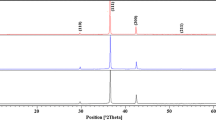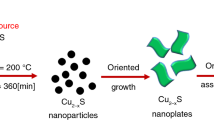Abstract
Flower-like CuS nanostructures have been synthesized via a liquid precipitation route by the reaction between CuCl2·2H2O and thioacetamide (CH3CSNH2, TAA) in the ionic liquid 1-butyl-3-methyl imidazole six hexafluorophosphoric acid salts ([BMIM][PF6]) aqueous solution at room temperature. The products were characterized by X-ray powder diffraction (XRD), field emission scanning electronic microscopy (FESEM), Brunauer-Emmett-Teller (BET), Ultraviolet-Visible Spectrophotometer (UV-Vis) and Photoluminescence (PL) techniques. The as-prepared CuS nanostructures have a mean diameter of about 1 μm. A plausible mechanism was proposed to explain the formation of CuS nanostructures. The effects of experimental parameters on the formation of the products were also explored. With BET theory, it is found that the as-prepared CuS nanostructures have a specific area of 39m2/g. The Barrett-Joyner-Halenda (BJH) pore size distribution of the as-prepared CuS nanostructures presents smaller pores centers about 60 nm.The UV-Vis and PL curves indicate that the asprepared CuS nanostructures are promising candidates for the development of photoelectric devices.
Similar content being viewed by others
References
Wang K J, Li G D, Wang Q, Chen J S. Formation of singlecrystalline CuS nanoplates vertically standing on flat substrate. Crystal Growth & Design, 2007, 7(11): 2265–2267
Mane R S, Lokhande C D. Chemical deposition method for metal chalcogenide thin films. Materials Chemistry and Physics, 2000, 1(65): 1–31
Roy P, Srivastava S K. Low-temperature synthesis of CuS nanorods by simple wet chemical method. Materials Letters, 2007, 61(8–9): 1693–1607
Raevskaya A E, Stroyuk A U, Kuchmii S Y, Kryukov A I. Catalytic activity of CuS nanoparticles in hydrosulfide ions air oxidation. Journal of Molecular Catalysis A: Chemical, 2004, 212(1–2): 259–265
Zhang Y C, Qian T, Hu X Y, Zhou W D. A facile low temperature solvothermal route to copper monosulfide submicrotubes. Materials Research Bulletin, 2005, 40(10): 1696–1704
Barrelet C J, Wu Y, Bell D C, Lieber C M. Synthesis of CdS and ZnS nanowires using single-source molecular precursors. Journal of the American Chemical Society, 2003, 125(38): 11498–11499
Xue P C, Lu R, Huang Y, Jin M, Tan C H, Bao C Y, Wang Z M, Zhao Y Y. Novel pearl-necklace porous CdS nanofiber templated by organogel. Langmuir, 2004, 20(15): 6470–6475
Xue P C, Lu R, Li D M, Jin M, Tan C, Bao C, Wang Z, Zhao Y, Zhao Y Y. Novel CuS nanofibers using organogel as a template: controlled by binding sites. Langmuir, 2004, 20(25): 11234–11239
Tan C H, Zhu Y L, Lu R, Xue P C, Bao C Y, Liu X L, Fei Z P, Zhao Y Y. Synthesis of copper sulfide nanotube in the hydrogel system. Materials Chemistry and Physics, 2005, 91(1): 44–47
Wu C Y, Yu S H, Chen S F, Liu G N, Liu B H. Large scale synthesis of uniform CuS nanotubes in ethylene glycol by a sacrificial templating method under mile conditions. Journal of Materials Chemistry, 2006, 16(32): 3326–3331
Ge L, Jing X Y, Wang J, Jamil S, Liu Q, Song D L, Xie Y, Yang P P, Zhang M L. Ionic liquid-assisted synthesis of CuS nestlike hollow spheres assembled by microflakes using an oil water interface route. Crystal Growth & Design, 2010, 10(4): 1688–1692
Gao J N, Li Q S, Zhao H B, Li L S, Liu C L, Gong Q H, Qi L M. One-pot synthesis of uniform Cu2O and CuS hollow spheres and their optical limiting properties. Chemistry of Materials, 2008, 20(19): 6263–6369
Shen X P, Zhao H, Shu H Q, Zhou H, Yuan A H. Self-assembly of CuS nanoflakes into flower-like microspheres: synthesis and characterization. Journal of Physics and Chemistry of Solids, 2009, 70(2): 422–427
Zhu L Y, Xie Y, Zheng XW, Liu X, Zhou G E. Fabrication of novel urchin-like architecture and snowflake-like pattern CuS. Journal of Crystal Growth, 2004, 260(3–4): 494–499
Zhang Y C, Hu X Y, Qiao T. Shape-controlled synthesis of CuS nanocrystallites via a facile hydrothermal route. Solid State Communications, 2004, 132(11): 779–782
Roy P, Mondal K, Srivastzva S K. Synthesis of twinned CuS nanorods by a simple wet chemical method. Crystal Growth & Design, 2008, 5(8): 1530–1534
Gao L, Wang E B, Lian S Y, Kang Z H, Lan Y, Wu D. Microemulsion-directed synthesis of different CuS nanocrystals. Solid State Communications, 2004, 130(5): 309–312
van Rantwijk F, Sheldon R A. Biocatalysis in ionic liquids. Chemical Reviews, 2007, 107(6): 2757–2785
Li Z H, Liu Z M, Zhang J L, Han B X, Du J M, Gao Y N, Jiang T. Synthesis of single-crystal gold nanosheets of large size in ionic liquids. Journal of Physical Chemistry B, 2005, 109(30): 14445–14448
Qin Y, Song N J, Zhao N N, Li M X, Qi L M. Ionic liquid-assisted growth of single-crystalline dendritic gold nanostructures with a three-fold symmetry. Chemistry of Materials, 2008, 20(12): 3965–3972
Wang Y, Yang H. Synthesis of CoPt nanorods in ionic liquids. Journal of the American Chemical Society, 2005, 127(15): 5316–5317
Thirumurugan A. Use of ionic liquids in synthesis of nanocrystals, nanorods and nanowires of elemental chalcogens. Bulletin of Materials Science, 2007, 30(2): 179–182
Movahedi M, Kowsari E, Mahjoub A R, Yavari I. A task specific basic ionic liquid for synthesis of flower-like ZnO by hydrothermal method. Materials Letters, 2008, 62(23): 3856–3858
Jiang Y, Zhu Y J. Microwave-assisted synthesis of sulfide M2S3 (M = Bi, Sb) nanorods using an ionic liquid. Journal of Physical Chemistry B, 2005, 109(10): 4361–4364
Zhu Y J, Wang W W, Qi R J, Hu X L. Microwave-assisted synthesis of single-crystalline tellurium nanorods and nanowires in ionic liquids. Angewandte Chemie, 2004, 43(11): 1410–1414
Jacob D S, Bitton L, Grinblat J, Felner I, Koltypin Y, Gedanken A. Are ionic liquids really a boon for the synthesis of inorganic materials? A general method for the fabrication of nanosized metal fluorides. Chemistry of Materials, 2006, 18(13): 3162–3168
He Y H, Li D Z, Chen Z X, Chen Y B, Fu X Z. New synthesis of single-crystalline InVO4 nanorods using an ionic liquid. Journal of the American Ceramic Society, 2007, 90(11): 3698–3703
Tang G H. Synthesis of nanometer powders by liquid precipitation. Shanxi Chemical Industry, 2005, 25(3): 8–10 (in Chinese)
Ding T Y, Wang M S, Guo S P, Guo G C, Huang J S. CuS nanoflowers prepared by a polyol route and their photocatalytic property. Materials Letters, 2008, 62(30): 4529–4531
Zhang J, Zhang Z K. Hydrothermal synthesis and optical properties of CuS nanoplates. Materials Letters, 2008, 62(15): 2279–2281
Thongtem T, Phuruangrant A, Thongtem S. Formation of CuS with flower like, hollow spherical, and tubular structures using the solvothermal-microwave process. Current Applied Physics, 2009, 9(1): 195–200
Pereiro A B, Legido J L, Rodríguez A. Physical properties of ionic liquids based on 1-alkyl-3-methylimidazolium cation and hexafluorophosphate as anion and temperature dependence. Journal of Chemical Thermodynamics, 2007, 39(8): 1168–1175
Zhang J, Zhang Z K. Shape-controlled synthesis of CuS nanocrystallites via a facial solution route. Journal of Functional Materials, 2007, 38: 2056–2058
Xu H L, Wang W Z, Zhu W, Zhou L. Synthesis of octahedral CuS nanocages via a solid-liquid reaction. Nanotechnology, 2006, 17(15): 3649–3654
Chen L F, Yu W, Li Y. Synthesis and characterization of tuber CuS with flower-like wall from a low temperature hydrothermal route. Powder Technology, 2009, 191(1–2): 52–54
Li F, Kong T, Bi W T, Li D C, Li Z, Huang X T. Synthesis and optical of CuS nanoplate-based architectures by a solvothermal method. Applied Surface Science, 2009, 255(12): 6285–6289
Author information
Authors and Affiliations
Corresponding author
Rights and permissions
About this article
Cite this article
Chen, C., Li, Q., Wang, Y. et al. Room temperature synthesis of flower-like CuS nanostructures under assistance of ionic liquid. Front. Optoelectron. China 4, 150–155 (2011). https://doi.org/10.1007/s12200-011-0167-4
Received:
Accepted:
Published:
Issue Date:
DOI: https://doi.org/10.1007/s12200-011-0167-4




